高三英语二轮复习动词时态指导课件(共24张PPT)
文档属性
| 名称 | 高三英语二轮复习动词时态指导课件(共24张PPT) | 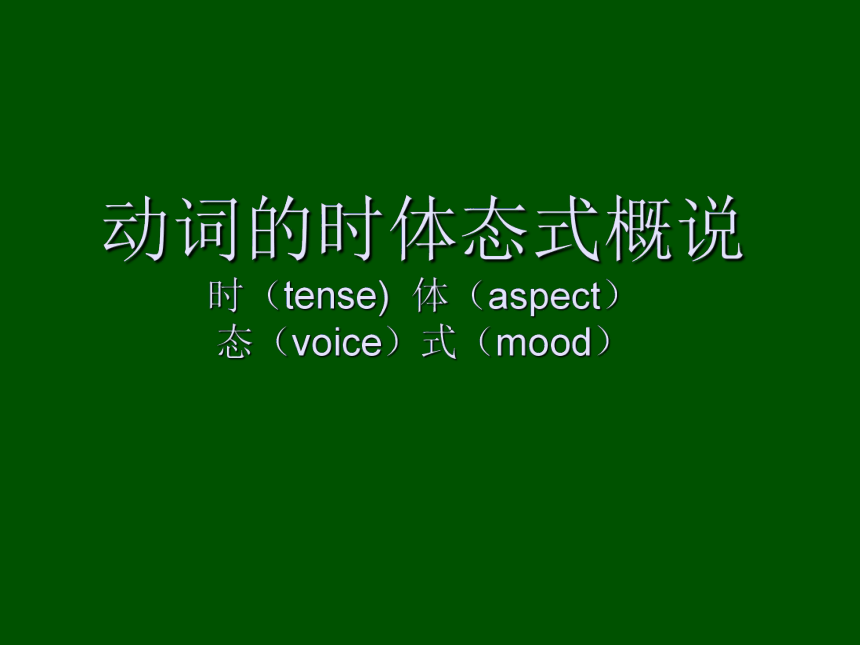 | |
| 格式 | pptx | ||
| 文件大小 | 81.6KB | ||
| 资源类型 | 教案 | ||
| 版本资源 | 通用版 | ||
| 科目 | 英语 | ||
| 更新时间 | 2023-02-20 22:51:49 | ||
图片预览

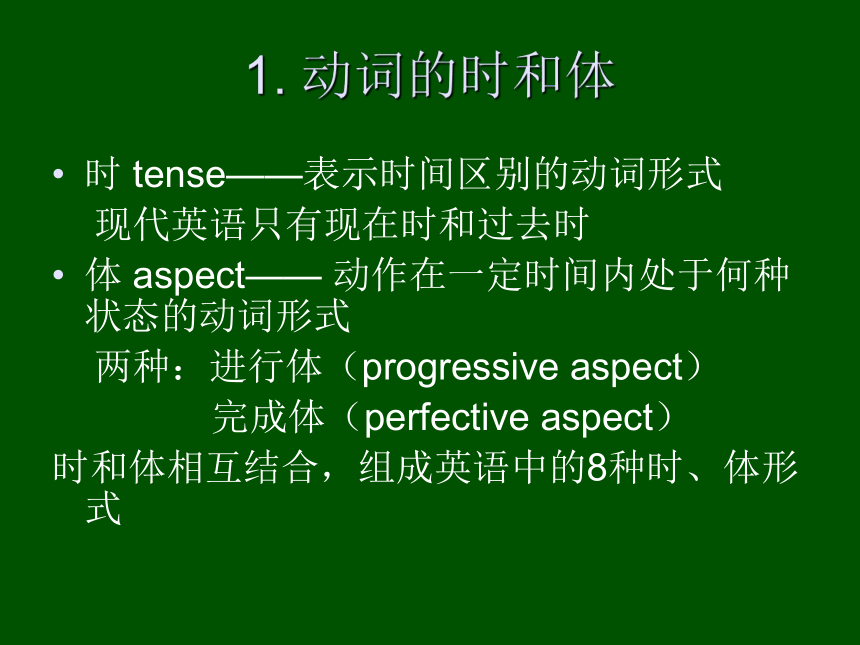
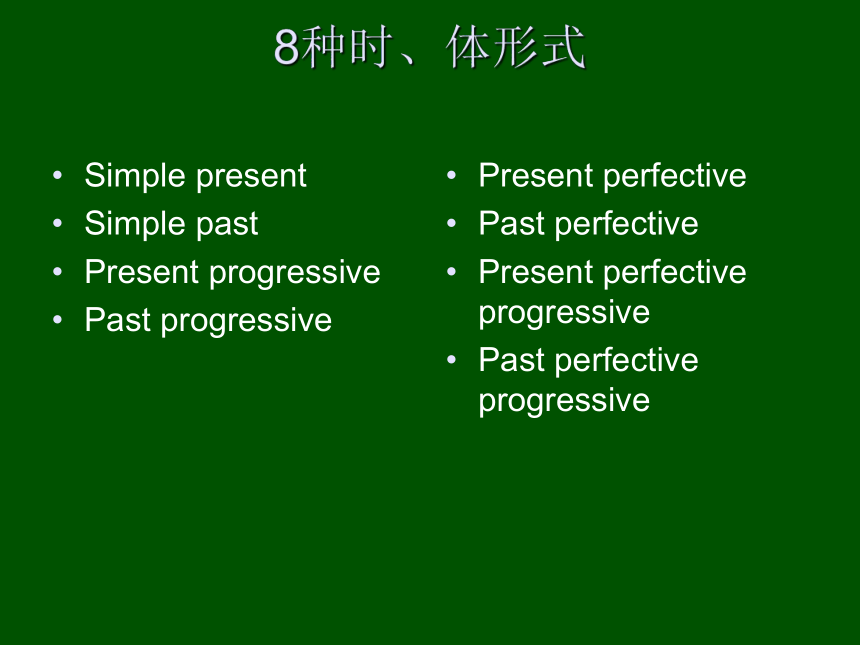
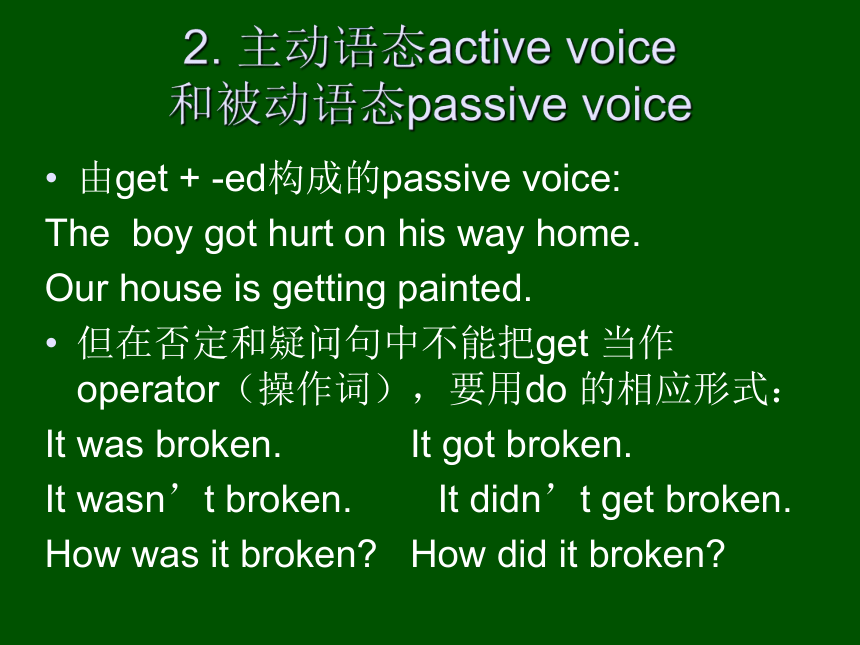
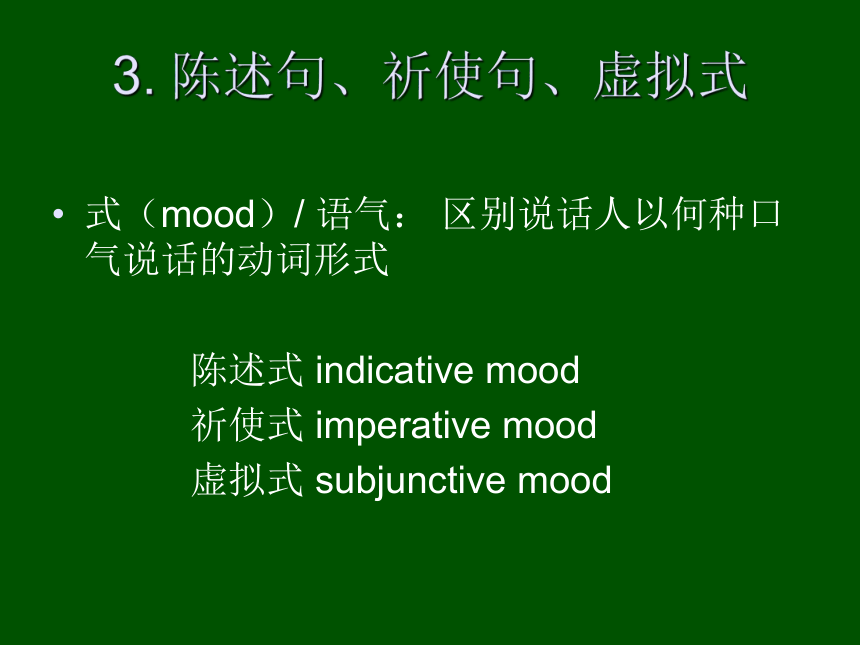
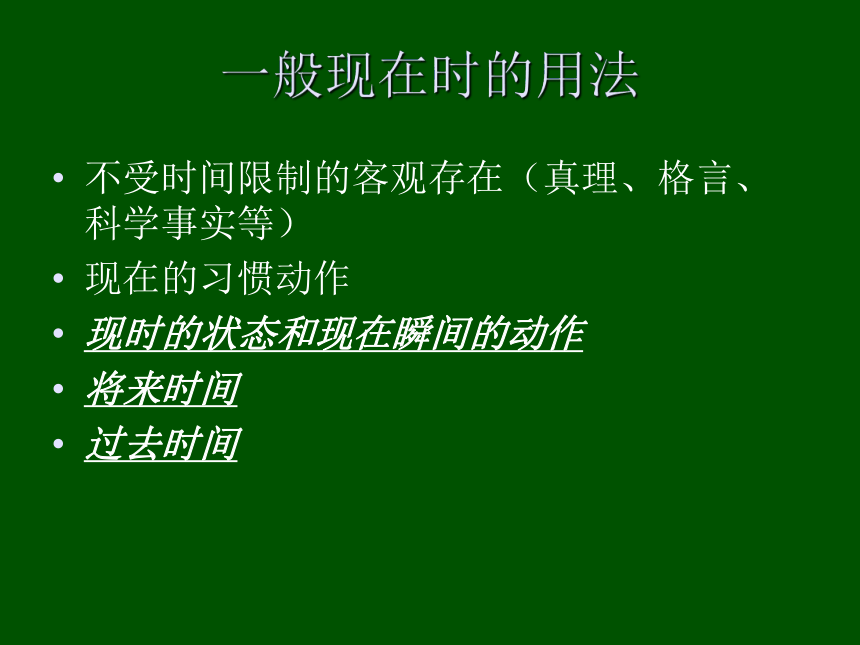

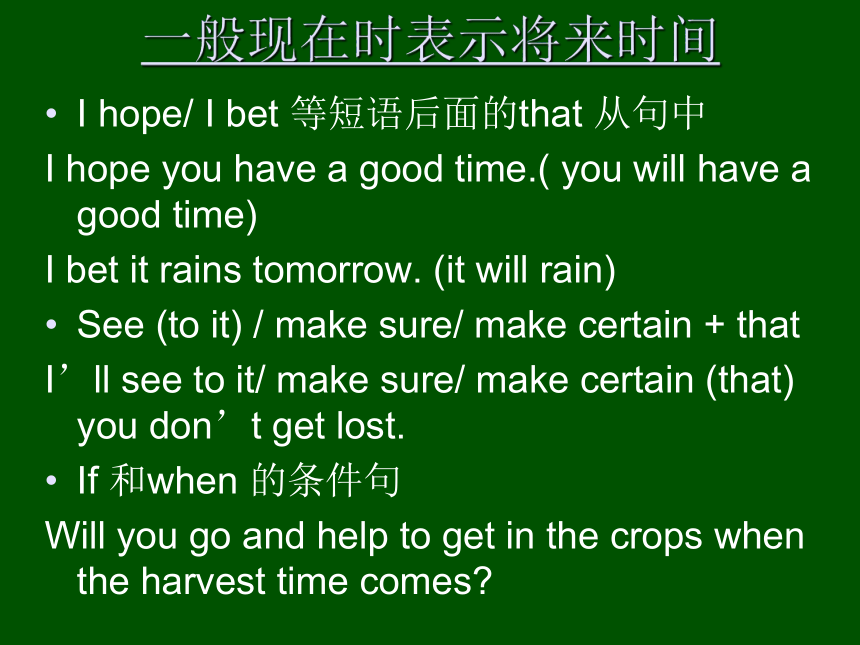
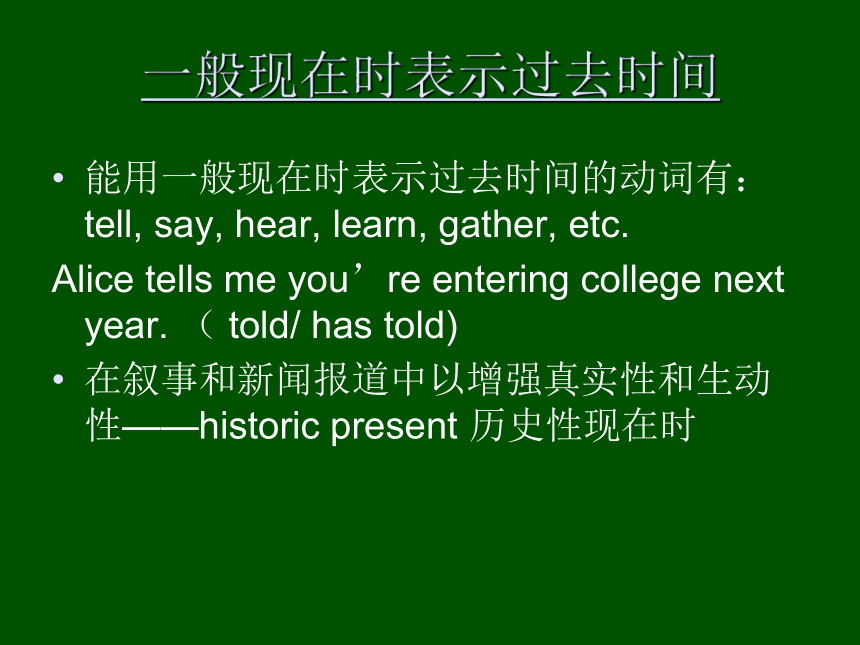
文档简介
(共24张PPT)
动词的时体态式概说
时(tense) 体(aspect)
态(voice)式(mood)
1. 动词的时和体
时 tense——表示时间区别的动词形式
现代英语只有现在时和过去时
体 aspect—— 动作在一定时间内处于何种状态的动词形式
两种:进行体(progressive aspect)
完成体(perfective aspect)
时和体相互结合,组成英语中的8种时、体形式
8种时、体形式
Simple present
Simple past
Present progressive
Past progressive
Present perfective
Past perfective
Present perfective progressive
Past perfective progressive
2. 主动语态active voice
和被动语态passive voice
由get + -ed构成的passive voice:
The boy got hurt on his way home.
Our house is getting painted.
但在否定和疑问句中不能把get 当作operator(操作词),要用do 的相应形式:
It was broken. It got broken.
It wasn’t broken. It didn’t get broken.
How was it broken How did it broken
3. 陈述句、祈使句、虚拟式
式(mood)/ 语气: 区别说话人以何种口气说话的动词形式
陈述式 indicative mood
祈使式 imperative mood
虚拟式 subjunctive mood
一般现在时的用法
不受时间限制的客观存在(真理、格言、科学事实等)
现在的习惯动作
现时的状态和现在瞬间的动作
将来时间
过去时间
现时的状态和现在瞬间的动作
现时状态——具有一定持续性,适用于静态动词。
Someone’s at the door, Carol.
动作转瞬即逝,话音未落已经完成。Eg. 体育运动的实况报道,表演、操作等的解说词。
Harper passes the ball to Jennings; Jennings shoots and the goalkeeper leaps for it---- yes, it’s a goal.
一般现在时表示将来时间
I hope/ I bet 等短语后面的that 从句中
I hope you have a good time.( you will have a good time)
I bet it rains tomorrow. (it will rain)
See (to it) / make sure/ make certain + that
I’ll see to it/ make sure/ make certain (that) you don’t get lost.
If 和when 的条件句
Will you go and help to get in the crops when the harvest time comes
一般现在时表示过去时间
能用一般现在时表示过去时间的动词有:tell, say, hear, learn, gather, etc.
Alice tells me you’re entering college next year. ( told/ has told)
在叙事和新闻报道中以增强真实性和生动性——historic present 历史性现在时
一般过去时的用法
过去时间
现在和将来时间
表示现在和将来时间
委婉口气. 限于want, wonder, think, hope 等词
—— Did you want me
—— Yes, I wondered if you could …
It’s time…./ I wish…/ I’d rather…+ that 等表示主观想法的从句中
1.Suppose we spend next week in Britain
2. He looks as if he is sick.
区分:
Suppose we spent next week in Britain (更婉转)
He looks as if he was sick.
(was= 虚拟式的were,“似乎病了”,实际未病。
is——看上去似乎真的病了)
现在进行体的用法
说话时正在进行的动作
现阶段一直进行的动作(说话时不一定正在进行)
Jane teaches English at Teachers’ College,
but she’s now teaching in a middle school.
同always, continually, for ever 连用——感
彩
You are always finding fault with me.
She is constantly complaining about the
house.
近期内按计划安排将要发生的动作
刚刚过去的动作
You don’t believe it You know I’m telling the truth.
委婉
I’m wondering if I may have a word with you.
过去进行体的用法
过去正在进行
过去某阶段的习惯性动作
George was getting up at 5 every day that
week. ( George used to get up at 9, but that
week, he got up at 5)
与always, continually, for ever 连用——感
彩
按计划安排将发生的过去将来的事
现在时间和将来时间里的动作
(1)委婉——hope, wonder, want
I was wondering if you’d like to come with me.
过去进行体比一般过去时更委婉
(2)主观臆想
表示现在时间的主观想法
I wish they were not talking so loudly.
It is time we were leaving.
将来时间的主观想法
I’d rather you were going at once.
If you were leaving tonight, I’d like to go with you.
这些句子中过去进行体可与一般过去时互换
由when, before, after, until 引导的分句中的过去完成体
通常一个动作用一般过去时,前一个动作用过去完成体。
Before , after 本身表示出了动作先后性,所以可以用两个一般过去时
The train (had) left before I reached the station.
能同时使用两个过去完成体的情况很少,但——by the time
By the time I (had) recovered from the shock, he had disappeared.
完成体与since 分句
Since分句——非持续性动词的一般过去时
主句——现在完成体
主句为 it be… 表示时间,be 可以用一般现在时代替现在完成时
It is three months since he wrote to me.
3. Since 分句中用持续性动词和静态动词的一般过去时
The house has been in bad repair since
he lived in it. ( The house has been in bad
repair since he moved out.)
I haven’t eaten snails since I was a
student at Indiana. ( I haven’t eaten… since I
left Indiana University.)
此时,如果让since分句的动作持续到说话
时间,用持续性动词或静态动词的现在完成
体。
The house has been in bad repair since he
has lived in it.
I haven’t eaten snails since I have been a
student at… .
Translate the following two sentences:
He has written to me frequently since I was ill.
He has written to me frequently since I have been ill.
自从我病愈以来,他经常给我来信。
自从我生病以来(现在还在病中),他经常给我来信
完成体与have got (to)
见教材
完成体在 It is the first time + that 中的使用
It is/ will be the first time + that的现在完成体
It is the first time I’ve been here.
It was the first time + that的过去完成体
It was the first time she had been at a summer school.
有时也用一般过去时,或现在完成体 (见教材)
动词的时体态式概说
时(tense) 体(aspect)
态(voice)式(mood)
1. 动词的时和体
时 tense——表示时间区别的动词形式
现代英语只有现在时和过去时
体 aspect—— 动作在一定时间内处于何种状态的动词形式
两种:进行体(progressive aspect)
完成体(perfective aspect)
时和体相互结合,组成英语中的8种时、体形式
8种时、体形式
Simple present
Simple past
Present progressive
Past progressive
Present perfective
Past perfective
Present perfective progressive
Past perfective progressive
2. 主动语态active voice
和被动语态passive voice
由get + -ed构成的passive voice:
The boy got hurt on his way home.
Our house is getting painted.
但在否定和疑问句中不能把get 当作operator(操作词),要用do 的相应形式:
It was broken. It got broken.
It wasn’t broken. It didn’t get broken.
How was it broken How did it broken
3. 陈述句、祈使句、虚拟式
式(mood)/ 语气: 区别说话人以何种口气说话的动词形式
陈述式 indicative mood
祈使式 imperative mood
虚拟式 subjunctive mood
一般现在时的用法
不受时间限制的客观存在(真理、格言、科学事实等)
现在的习惯动作
现时的状态和现在瞬间的动作
将来时间
过去时间
现时的状态和现在瞬间的动作
现时状态——具有一定持续性,适用于静态动词。
Someone’s at the door, Carol.
动作转瞬即逝,话音未落已经完成。Eg. 体育运动的实况报道,表演、操作等的解说词。
Harper passes the ball to Jennings; Jennings shoots and the goalkeeper leaps for it---- yes, it’s a goal.
一般现在时表示将来时间
I hope/ I bet 等短语后面的that 从句中
I hope you have a good time.( you will have a good time)
I bet it rains tomorrow. (it will rain)
See (to it) / make sure/ make certain + that
I’ll see to it/ make sure/ make certain (that) you don’t get lost.
If 和when 的条件句
Will you go and help to get in the crops when the harvest time comes
一般现在时表示过去时间
能用一般现在时表示过去时间的动词有:tell, say, hear, learn, gather, etc.
Alice tells me you’re entering college next year. ( told/ has told)
在叙事和新闻报道中以增强真实性和生动性——historic present 历史性现在时
一般过去时的用法
过去时间
现在和将来时间
表示现在和将来时间
委婉口气. 限于want, wonder, think, hope 等词
—— Did you want me
—— Yes, I wondered if you could …
It’s time…./ I wish…/ I’d rather…+ that 等表示主观想法的从句中
1.Suppose we spend next week in Britain
2. He looks as if he is sick.
区分:
Suppose we spent next week in Britain (更婉转)
He looks as if he was sick.
(was= 虚拟式的were,“似乎病了”,实际未病。
is——看上去似乎真的病了)
现在进行体的用法
说话时正在进行的动作
现阶段一直进行的动作(说话时不一定正在进行)
Jane teaches English at Teachers’ College,
but she’s now teaching in a middle school.
同always, continually, for ever 连用——感
彩
You are always finding fault with me.
She is constantly complaining about the
house.
近期内按计划安排将要发生的动作
刚刚过去的动作
You don’t believe it You know I’m telling the truth.
委婉
I’m wondering if I may have a word with you.
过去进行体的用法
过去正在进行
过去某阶段的习惯性动作
George was getting up at 5 every day that
week. ( George used to get up at 9, but that
week, he got up at 5)
与always, continually, for ever 连用——感
彩
按计划安排将发生的过去将来的事
现在时间和将来时间里的动作
(1)委婉——hope, wonder, want
I was wondering if you’d like to come with me.
过去进行体比一般过去时更委婉
(2)主观臆想
表示现在时间的主观想法
I wish they were not talking so loudly.
It is time we were leaving.
将来时间的主观想法
I’d rather you were going at once.
If you were leaving tonight, I’d like to go with you.
这些句子中过去进行体可与一般过去时互换
由when, before, after, until 引导的分句中的过去完成体
通常一个动作用一般过去时,前一个动作用过去完成体。
Before , after 本身表示出了动作先后性,所以可以用两个一般过去时
The train (had) left before I reached the station.
能同时使用两个过去完成体的情况很少,但——by the time
By the time I (had) recovered from the shock, he had disappeared.
完成体与since 分句
Since分句——非持续性动词的一般过去时
主句——现在完成体
主句为 it be… 表示时间,be 可以用一般现在时代替现在完成时
It is three months since he wrote to me.
3. Since 分句中用持续性动词和静态动词的一般过去时
The house has been in bad repair since
he lived in it. ( The house has been in bad
repair since he moved out.)
I haven’t eaten snails since I was a
student at Indiana. ( I haven’t eaten… since I
left Indiana University.)
此时,如果让since分句的动作持续到说话
时间,用持续性动词或静态动词的现在完成
体。
The house has been in bad repair since he
has lived in it.
I haven’t eaten snails since I have been a
student at… .
Translate the following two sentences:
He has written to me frequently since I was ill.
He has written to me frequently since I have been ill.
自从我病愈以来,他经常给我来信。
自从我生病以来(现在还在病中),他经常给我来信
完成体与have got (to)
见教材
完成体在 It is the first time + that 中的使用
It is/ will be the first time + that的现在完成体
It is the first time I’ve been here.
It was the first time + that的过去完成体
It was the first time she had been at a summer school.
有时也用一般过去时,或现在完成体 (见教材)
